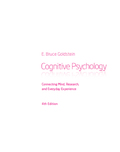
Introduction
Oblique effect refers to the relative deficiency in performance with respect to the perception of oblique contours in comparison to the performance of vertical or horizontal contours. Two factors may play a role in causing this effect, namely evolution and experience.
Explanation of Solution
Answer and explanation
Oblique effect makes it possible for humans' discriminability of direction or orientation to be significantly better around vertical or horizontal axes, in comparison to a slanted one. Individuals' experience with such physical properties of the environment, natural as well as man-made, can affect this effect. This is so because human-made surroundings, like buildings, are comprised of a number of verticals as well as horizontals, whereas natural ones are comprised of plants and trees that are more likely to be straight or perpendicular. This might have also evolved humans via their experience to be more comfortable with vertical/horizontal positioning than a rarely observed tilted one.
Through evolution, creatures whose optical systems are comprised of nerve cells can significantly fire the things to the surrounding, for example, vertical contours have an increased probability of surviving and passing on its abilities. In contrast, the creatures having only the visual organization, which do not encompass the specific neuron set are not able to sense the upright entities.
Want to see more full solutions like this?
Chapter 3 Solutions
EBK COGNITIVE PSYCHOLOGY: CONNECTING MI
- How can social workers effectively apply strengths-based, and empowerment approaches to promote clients' self-determination and resilience while considering the cultural contexts and values that shape their experiences and identities? Please cite in text and list reference.arrow_forwardFill in the temperature values in table 1-2 for the standard atmosphere from 2000 to 10000 metersarrow_forwardBailey and Burch 25 Essential Skills and Strategies for Behavior Analysts. Chapter 14 In this chapter, Drs. Bailey and Burch extol the value of “shaping, shaping, always shaping” – in one’s professional and personal life. What do they mean by this? Shaping can be used for either a problem that is due to a skill deficit (in which shaping is used to teach the needed behavior) or is due to a motivational problem (in which case, shaping is used to gradually move the person to “yes”). Describe a situation in which it would be appropriate – and useful for all concerned – to use shaping when the problem is due to a skill deficit. Why would it be appropriate to use shaping in this situation? How would you do it? Describe a situation in which it would be appropriate – and useful for all concerned – to use shaping when the problem is a motivational problem. Why would it be appropriate to use shaping in this situation? How would you do it? Describe a situation in which…arrow_forward
- sketch a life map for reflectionarrow_forwardDr. Schlinger discusses delay discounting, ACT, RFT, and PBIS, and explains why he does not believe that they are behavior analysis. What is missing from them, that renders them “not behavior analysis,” in Dr. Schlinger’s well-considered opinion? Dr. Schlinger has concerns regarding the BACB and behavior analyst certification. Explain Dr. Schlinger’s concern with regard to the BACB. Why would Dr. Schlinger choose a degree program in experimental analysis of behavior, rather than one of the newer programs that prepares graduates to sit for the BCBA exam? Why does Dr. Schlinger contend that many BCBAs are not actually behavior analysts? Describe Dr. Schlinger’s concern regarding a “slow moving coup” in ABAI. Watch Dr. Schlinger’s recording entitled “Threats to Behavior Analysis.arrow_forwardwhat is perculiar about buddhism?arrow_forward
- what is religion?arrow_forwardThis assignment aims to develop your skills in recognizing and articulating the characteristics of melodies. It encourages critical thinking about the compositional elements that contribute to the uniqueness and beauty of different melodic lines. Select a Melody: Choose a specific melody from a song, piece of classical music, or any musical genre that captivates you. Provide the title and artist/composer of the chosen piece. Melodic Analysis: In 150 words, provide a brief musical analysis of your melody by identifying the following characteristics: Rhythm: Examine the rhythm of the melody. Identify its pulse, meter, accents, or characteristic rhythmic patterns. Is it predictable and consistent? Contour: Analyze the overall shape of the melody. Is its direction ascending, descending, or a combination of both? Phrasing: Identify the phrases within the melody. How are they structured, and do they contribute to the overall flow? Is the phrase paired in an antecedent (question) and…arrow_forwardMach terms with short description. Prompt Answers Tonic Chord with three notes Dissonance Unstable Conssonance Stable Triad First note of a scalearrow_forward
- Match each tempo indication with its definition. Prompt Answers Largo Very, very slow Moderato Fast Allegro Lively Vivace Moderatearrow_forward1.3 worksheet part 3 true way aslarrow_forwardCritically discuss how the media depiction of the 'ideal' bodies influences stress and self-esteem levels in male and female adolescents. An examination of biological, psychological and social factors".arrow_forward
 Ciccarelli: Psychology_5 (5th Edition)PsychologyISBN:9780134477961Author:Saundra K. Ciccarelli, J. Noland WhitePublisher:PEARSON
Ciccarelli: Psychology_5 (5th Edition)PsychologyISBN:9780134477961Author:Saundra K. Ciccarelli, J. Noland WhitePublisher:PEARSON Cognitive PsychologyPsychologyISBN:9781337408271Author:Goldstein, E. Bruce.Publisher:Cengage Learning,
Cognitive PsychologyPsychologyISBN:9781337408271Author:Goldstein, E. Bruce.Publisher:Cengage Learning, Introduction to Psychology: Gateways to Mind and ...PsychologyISBN:9781337565691Author:Dennis Coon, John O. Mitterer, Tanya S. MartiniPublisher:Cengage Learning
Introduction to Psychology: Gateways to Mind and ...PsychologyISBN:9781337565691Author:Dennis Coon, John O. Mitterer, Tanya S. MartiniPublisher:Cengage Learning Psychology in Your Life (Second Edition)PsychologyISBN:9780393265156Author:Sarah Grison, Michael GazzanigaPublisher:W. W. Norton & Company
Psychology in Your Life (Second Edition)PsychologyISBN:9780393265156Author:Sarah Grison, Michael GazzanigaPublisher:W. W. Norton & Company Cognitive Psychology: Connecting Mind, Research a...PsychologyISBN:9781285763880Author:E. Bruce GoldsteinPublisher:Cengage Learning
Cognitive Psychology: Connecting Mind, Research a...PsychologyISBN:9781285763880Author:E. Bruce GoldsteinPublisher:Cengage Learning Theories of Personality (MindTap Course List)PsychologyISBN:9781305652958Author:Duane P. Schultz, Sydney Ellen SchultzPublisher:Cengage Learning
Theories of Personality (MindTap Course List)PsychologyISBN:9781305652958Author:Duane P. Schultz, Sydney Ellen SchultzPublisher:Cengage Learning





